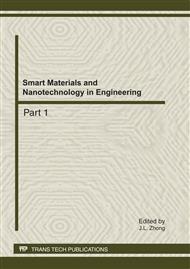[1]
Wangqiu. phenomenon of bio-mucosa on Coating surface, Shanghai Coating, vol. 1, pp.20-23, 2000(in Chinese).
Google Scholar
[2]
Horbund HM, Freiberger A. Slime films and their role in marine fouling: A review, Ocean Eng, vol. 8, no. 6, pp.631-634, (1970).
DOI: 10.1016/0029-8018(70)90006-5
Google Scholar
[3]
Yebra DM, Kiil S, Johansen KD. Antifouling technology—past, present and future steps towards efficient and environmentally friendly antifouling coatings, Prog Org Coat, vol. 50, no. 2, pp.75-104, (2004).
DOI: 10.1016/j.porgcoat.2003.06.001
Google Scholar
[4]
AM Baty, PA Suci, BJ Tyler, GG Geesey . Investigation of mussel adhesive protein adsorption on polystyrene and poly (octadecyl methacrylate) using angle dependent XPS, ATR-FTIR, and AFM, Journal of Colloid and Interface Science, Vol. 177, no. 2, pp.307-315, February (1996).
DOI: 10.1006/jcis.1996.0036
Google Scholar
[5]
Filpula DR, Lee SM, Link RP, Strausberg SL, Strausberg RL. Structural and functional repetition in a marine mussel adhesive protein, Biotechnol Prog., vol. 6, no. 3, pp.171-177, (1990).
DOI: 10.1021/bp00003a001
Google Scholar
[6]
[Olivieri MP, Baier RE, Loomis RE. Surface properties of mussel adhesive protein component films, Biomaterials, vol. 13, no. 14, pp.1000-1008, (1992).
DOI: 10.1016/0142-9612(92)90150-m
Google Scholar
[7]
Green K, Berdecia R, Cheeks L. Mussel adhesive protein: permeability characteristics when used as a basement membrane, Curr Eye Res., vol. 6, no. 6, pp.835-838, Jun (1987).
DOI: 10.3109/02713688709034851
Google Scholar
[8]
Maja Wiegemann and Burkard Watermann . [J]. Journal of Adhesion Science and Technology, Volume 17(14), 2003. 12: 1957-(1977).
Google Scholar
[9]
HU Wei-Ling, WU Ling-Ling, ZHOU Jing. Electrochemistry , 1999, 5(3): 299-303 (in Chinese).
Google Scholar
[10]
HUANG Y. , IWATA M. , USAMI M., UEDA K. [CP]. Proc. Int. Offshore Polar Eng. Conf. Brest, May 30-June 4 (1999).
Google Scholar
[11]
USAMI M., HUANG Y., UEDA K., IWATA M. [J]. J. Soc. Nav. Archit. Jpn. 1998, vol. 183: 375-382.
Google Scholar
[12]
S.K. Chen, B.C. Wang, T.G. Zhou, Theoretical investigation on the reaction of adhesion unit DOPA in mussel with electrolyzing seawater, Colloids and Surfaces B: Biointerfaces, vol. 70, no. 2, pp.243-247, May. (2009).
DOI: 10.1016/j.colsurfb.2008.12.033
Google Scholar
[13]
Chen Shuangkou, Wang Bochu,Zhou Taigang, Theoretical study of the oxidizing mechanism for the reaction of HClO and adhesive unit DOPA in the mussel, Computer and Applied Chemistry, vol. 26, no. 7, pp.917-920, July (2009).
Google Scholar
[14]
CHEN Shuangkou, WANG Bochu, ZHOU Tai gang, Theoretical studies on the oxidizing mechanism for the reaction of HClO and adhesive unit DOPA-DOPA in the mussel, JOURNAL OF MOLECULAR SCIENCE, vol. 24, no. 1, pp.42-45, Jan (2008).
Google Scholar


